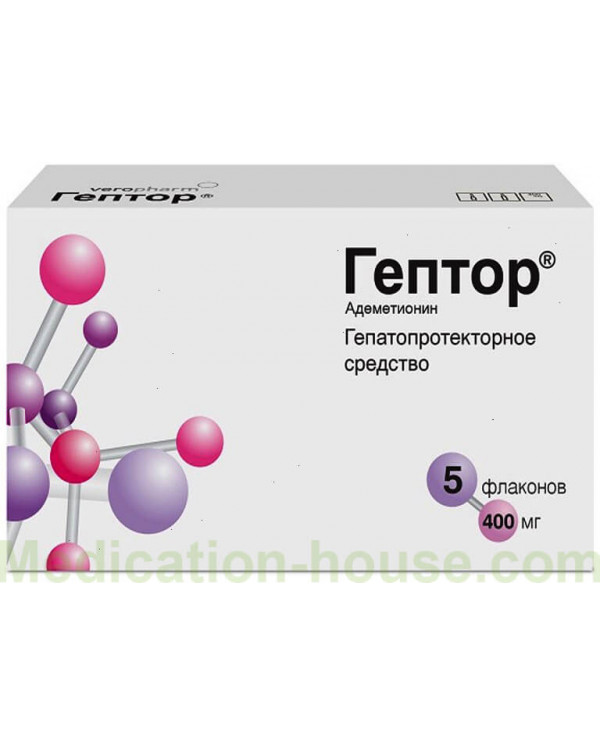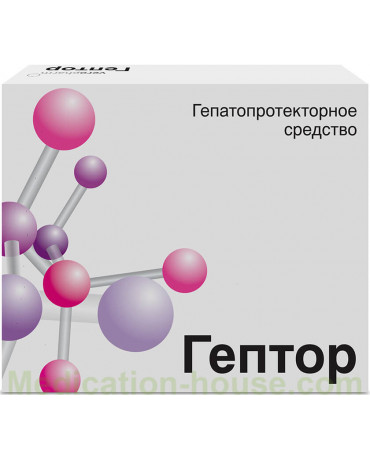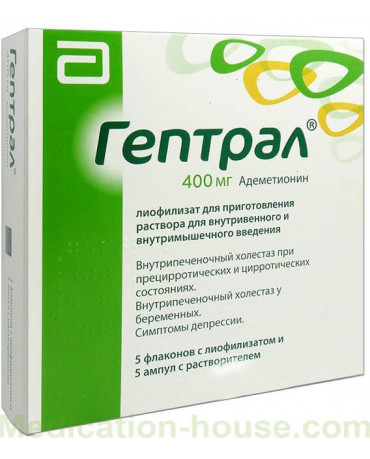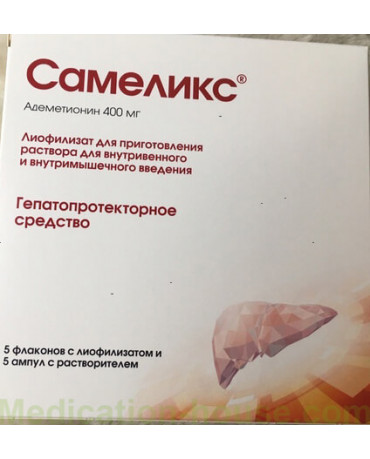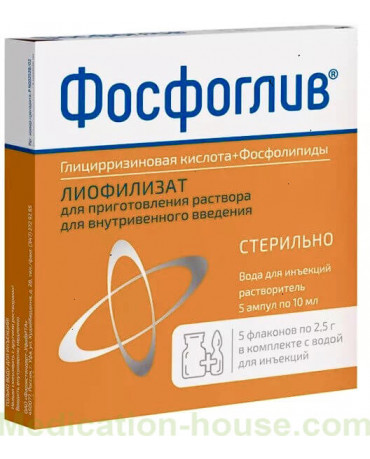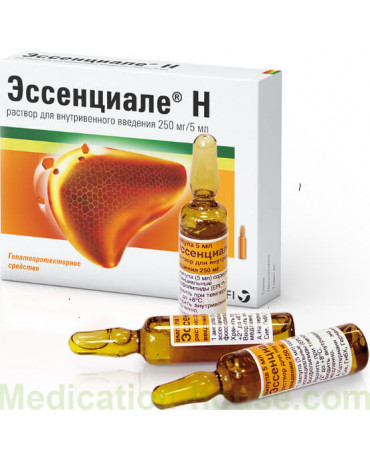Instruction for Heptor injections
Reed more and buy Heptor injections here
Release form and active ingredient
Along with convex tablets having a shell, a lyophilisate is produced for the preparation of the solution. It is injected into a vein or intramuscularly. The package includes:
Lyophilisate powder is a mass of white or white-yellow type. It has no auxiliary components and is packaged in bottles. In each of them there is an active component - ademethionine in an amount of 400 mg (or 760 mg of ademethionine 1,4-butanedisulfonate).
A solvent of a transparent type, having shades from yellow to colorless, with a special smell. 1 ml of this liquid contains 68.48 mg of L-lysine in the form of a monohydrate. Additionally, the composition contains sodium hydroxide in solution - up to a pH of 9.8-10.3 and liquid for injection.
5 vials with the main component and 5 ampoules containing 5 ml of solvent are packed in a cardboard packaging package. To prepare the liquid for injection, you need to mix the components. The resulting liquid will be transparent, with a light yellow color or colorless. There is no visible precipitate.
Ademethionine, which is an active component in the composition of the heptor injections, is involved in a number of biochemically active processes that occur in the body. In this case, the production of endogenous type ademethionine is activated. This component is present in tissues and biological fluids. In addition, it precedes a variety of polyamines. Promotes the presence of putrescine, which activates the regenerative processes in the cells, promotes the proliferation of hepatocytes.
Pharmacokinetic features
The heptor is injected intravenously or into the muscle. If the bioavailability parameter in the case of oral administration of tablets is 5%, then with the intramuscular injection route, this indicator reaches 95%. The penetration of the active component occurs through the BBB. With injection injections into a muscle or vein, as well as during the administration of tablets, there is a significant increase in the saturation of Ademethionine with a cerebrospinal fluid. Biotransformation processes occur in the liver, and the conclusion is carried out through the work of the kidneys with a half-life of up to 1.5 hours.
Therapeutic effect of the drug
Ademethionine, which is part of the Heptor injections, provides a variety of therapeutic effects from the use of this drug. Since the greatest natural content of this substance is observed in the brain and liver, it is precisely these organs that the main action of the drug is directed to.
Due to the hepatoprotective effect, there is an increase in the resistance of liver cells to the effects of various negative type factors. Cells increase their strength against damage. The activity of this body is growing. At the same time, the formation and reproduction of cells is intensified, as well as the replacement of the dead with emerging elements. The prophylactic effect against cirrhosis or liver fibrosis against the background of chronic ailments is based on this effect.
The choleretic and cholekinetic nature of the effect is based on stimulating the formation of bile and increasing the intensity of its outflow. The elimination of the effect of stagnation of bile increases the efficiency of the liver without expanding its ducts. At the same time, taking the drug provides the prevention of inflammation in this organ. A more active outflow provides a fight against cholestasis and lengthens the period of remission in patients with cholecystitis.
Injection administration of the drug reduces the production and neutralizes harmful substances that are generated by organs and tissues or penetrate into the body from the external environment. The detoxifying effect promotes the active detoxification of the toxins by the liver. At the same time, the antioxidant effect is also known, due to which the cells more resistant to the negative effects of free radicals.
The role of the heptor injections as a neuroprotective is associated with the strengthening of brain cells and fibers of nerve elements. In the case of severe intoxication reactions, the likelihood of the appearance and increase in the manifestations of encephalopathy is minimized. At the same time, the intensity of reproduction and renewal of NS cells increases, which has a positive effect in the fight against fibrosis and sclerosis.
The use of the drug helps to stop depression and counteract their relapses. The antidepressant effect maximizes the benefit at the end of the 14-day treatment period, although by the end of the first seven days you can feel the onset of a positive effect.
Indications for use
Heptor injections are used in the treatment of ailments accompanied by biliary stasis:
fatty degeneration of this organ;
hepatitis of various origins, including due to the action of viruses, toxic reaction, drug origin, as well as chronic type;
lesions of the liver with alcohol or drug components;
chronic cholecystitis, not accompanied by the formation of stones;
cholangitis;
cirrhosis of the liver;
encephalopathy, including and caused by liver failure.
Important! The drug is also prescribed in the treatment of depressive syndrome, as well as in the case of active withdrawal syndrome of alcoholic origin.
Contraindications
It is strictly forbidden to take the drug in a number of patient categories:
under the age of 18;
pregnant women in the I – II trimester;
with intolerance to the components that are the components of this drug.
Important! For women during lactation, the possibility of taking the drug is considered from the perspective of correlating the benefits for the patient and the dangers for the unborn child.
How to use heptor injection
When heptor injections is prescribed to a person, injections should be made according to the instructions for use. It is necessary to observe the rules for preparing the liquid for administration and the procedure for its introduction into the muscle or vein.
Drug administration procedure
The heptor injections pack contains vials containing the lyophilisate, as well as the corresponding number of vials with a dissolving liquid. The latter component is recommended to be used in the process of giving the drug the form necessary for effective administration without risk to health in a vein or intramuscularly.
Usually, with liver ailments and its pathological changes, 400-800 mg daily should be administered intramuscularly or into a vein. This corresponds to 1-2 bottles with the active substance. The course of treatment is two weeks every day. If there is a need to continue treatment, then after injections, switch to the use of tablets of 800-1600 mg daily. The duration of subsequent oral administration is not more than 4 weeks.
To eliminate depressive syndromes, injections with a total volume of 400 - 800 mg per day are required. The duration of the treatment period is 2-3 weeks. After a course of drug administration through a vein or muscle, if necessary, use another treatment regimen - taking in tablet form 800–1600 mg daily. The course will be 14-28 days.
How to prepare a solution for administration
The introduction of the drug into the veins is considered a more preferred treatment option compared with the use of an intramuscular character. This fact is due to the reduced risks of complications of various types. Dilute the product should be for a very short period of time before using the solution. It is impossible to store a diluted preparation, therefore, unused residues should be disposed of as soon as possible. It is unacceptable to mix Heptor with solutions in the structure of which calcium ions are present. However, compatibility with other formulations intended for infusion, for example, with glucose and saline, is noted.
In the process of preparation, a solvent-liquid is first collected in the syringe, and then introduced into the vial with the lyophilisate. Do this carefully to prevent the dispersion of particles of the substance on the walls of the tank. For maximum dissolution, you need to make a gentle shaking of the bottle.
After dissolving the lyophilisate, a solution should be obtained with the absence of any impurities. Insoluble particles should also be absent. The color of the solution is white or white-yellow. Deviations from these parameters indicate the inadmissibility of the use of the drug.
Features of intravenous infusion
The heptor solution is injected vein jet or by infusion. In the first version of manipulations, the drug is injected into a vein similarly to intramuscular injection. In the second case, the process will be slower, drip. Therefore, the solution is mixed with saline in a volume of 250-500 ml.
If the introduction is jet, then the drug is drawn into a syringe. It is advisable to choose only a thin intravenous needle. With a vertical arrangement of the syringe, air bubbles are removed from it. Then the place of entry of the needle is rubbed with an antiseptic. The needle enters the vein, and the solution slowly, over 2-3 minutes, is administered as directed. After the procedure, the injection site is wiped with an antiseptic.
During intravenous infusion, the agent is diluted with a solvent liquid. Then it is poured into a solution intended for infusion (saline or glucose 5%) in a proportion of 1 vial. Heptor in 250 ml of liquid. After connecting to the system, the injection rate should be 15-25 drops / min.
Intramuscular administration
After diluting the drug, the solution is drawn into a syringe with a fairly long needle. A thick needle design is chosen for intramuscular use. Then let air out of the liquid. The injection site is treated with an antiseptic. It is advisable to inject the heptor intramuscularly into the lateral third of the upper thigh or the upper third of the shoulder of the external location. When injected into the buttock, there is a risk of subcutaneous injection.
The needle should be inserted deeper into the fabric - vertically to a place on the surface. After removing the needle, the place is treated with an antiseptic. Since the course of treatment is long, with each subsequent injection it is necessary to move 1 cm from the previously used place. Otherwise, bruising and abscesses may occur.
Overdose and side effects
No evidence of overdose by this drug was found. In general, patients are well tolerated, however, with the injection method of administration, some side effects are possible:
heartburn;
gastralgic reaction;
manifestations of an allergic nature;
manifestation of dyspepsia.
Possible negative processes on the surface of the skin (rash or itching), NS reaction (dizziness, headaches, lack of sleep). There have been cases of manifestation of phlebitis of the veins of a superficial location, hot flashes, as well as muscle cramps. A negative effect is possible on the gastrointestinal tract - nausea, vomiting, colic, dry mouth, flatulence, etc.
Application Specific Requirements
There are situations requiring careful use of the drug in short-term and long-term therapy. The introduction of the drug intramuscularly or into a vein is carried out only with the agreement of the doctor and by his decision.
Special cases
Persons over 65 years of age tolerate the drug well, so the standard dosage is not reduced. At the same time, it is recommended to use the minimum dosage level with a gradual return to normal in the initial days of admission.
When taking heptor injections, a feeling of anxiety may occur, which can be eliminated by changing the dosage. Do not delay taking the medicine. Due to the effect of the tonic effect, it is not advisable to give injections on the eve of sleep.
When the patient is diagnosed with cirrhosis of the liver, then during heptor injections therapy it is necessary to control the blood composition and monitor the parameters of the residual nitrogen in it. It is also important to know the indicators of the presence of urea in the blood, as well as creatinine. The lack of B vitamins, together with the limited intake of folic acid, negatively affects the absorption of the drug. With a lack of these components, it is advisable to introduce these components into the therapeutic course.
Important! In bipolar disorder, treatment with ademetionine can lead to inversion of affect.
Assignment to children
The drug is not prescribed for children under 18 years of age.
Pregnancy treatment
It is strictly forbidden to take the drug during the first two trimesters of pregnancy. Appointment in the third trimester is possible, but only by decision of the doctor and with regular monitoring of the condition of the mother and fetus.
During breastfeeding, the use of a medical device is allowed in consultation with the doctor. At the same time, the possibility of suspending breastfeeding is considered, and the health risks of both the mother and the child are assessed.
Interaction with other means
Reliably identified information about the interaction with other medicinal substances is not defined. However, it is advisable to refrain from co-administration with tricyclic antidepressants. It is not advisable to include Heptor in therapy if the patient is already taking selective inhibitors that provide reuptake of serotonin, as well as medications containing tryptophan.
Keep ampoules in a dry and dark place. The temperature is not more than 25 degrees heat. The shelf life of the lyophilisate is 2 years, and the solvent is 3 years.
Terms of sell
You don't need a prescription to buy Heptor injections.

